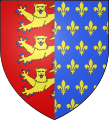Heraldry and The Crusades Part 6
The crescent was not the only heraldic symbol that has survived from the crusades. Other notable charges dating from the time of the crusades are the escallop shell and the water bouget, it does not however follow that every family that bore such emblem s on their Coats of Arms have an ancestor that took part in the crusades, as these charges passed into general heraldic use, and were adopted by many men whose forefathers never traveled to the Holy Land. The “escallop shell of quiet” was an emblem of pilgrimage. Assigned as a badge to St. James, patron saint of pilgrims, with reference to his original occupation as a fisherman, it was worn by those who made pilgrimages not only to the Holy Land but to the famous shrines in England and other European countries. From its use on garments to its appearance in armorial shields was a natural step, and the shell became a familiar heraldic charge from an early date.
A number of Coats of Arms, which contain escallop shells, clearly refer to the crusades. The family of Villiers have borne a silver shield with a red cross, and theron five gold escallops, since Sir Richard Villiers took part in the crusade of Prince Edward. He relinquished his old Arms; Sable three cinquefoils argent, derived from the cinquefoil of his feudal lord, the Earl of Leicester, for the newer one combining the emblems of St. George and St. James. A more famous bearer of these Arms was Villiers de L’Isle-Aadam, the last Grand Master of the Knights of St. John of Rhodes, who led the heroic defense of Rhodes against the forces of Soliman the Magnificent in 1522. A cross and three escallop shells appear in the Arms of John Kendal, Prior of the English Knights of St. John of Jerusalem in 1480 and commander of the cavalry protecting pilgrims from the Turks. The family of D’Acre supposedly took their name from an ancestor who distinguished himself at the siege of Acre. Their Coat of Arms is a red background with three escallop shells in silver, Gules three escallops argent.
The water bouget, a pair of leather bottles borne on a staff over the shoulder , was a very important object to armies in the deserts of the Middle East, and naturally finds a place in the Heraldry of the crusades. It appears in the Arms of Roos, who derived it from their kinsmen, the Trusbuts; and the three bougets-trois boutz- in the shield of the latter family are clearly a pun on their name. The three blue water bougets on a gold field , Or three water bougets azure, of the Bouchiers may have denoted some ancestor’s part on a crusade, especially as their crest is a Saracen king’s head. But here again we can trace it to a pun on the name, as the family name variously appears as Bucy, Boues, and Bouser, suggesting the old word for drink.


























